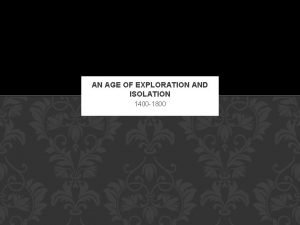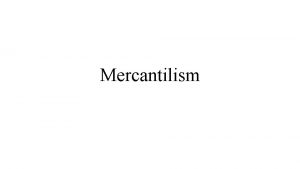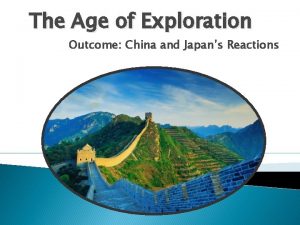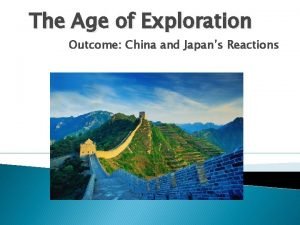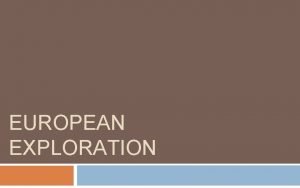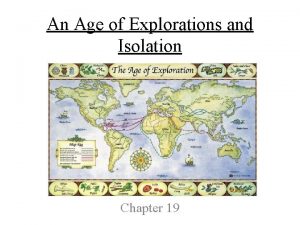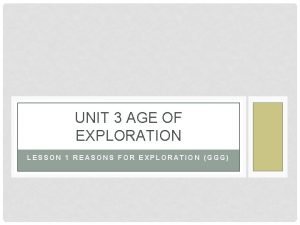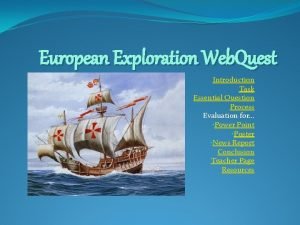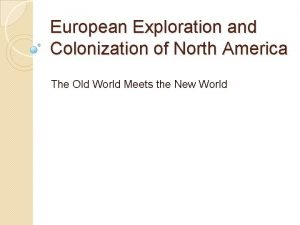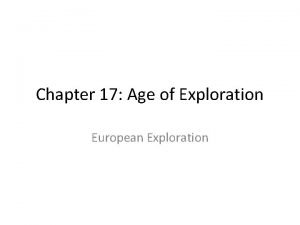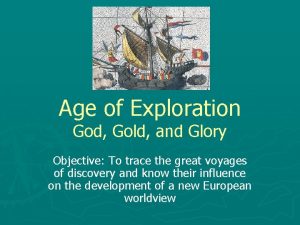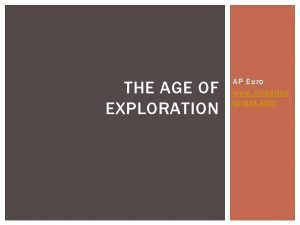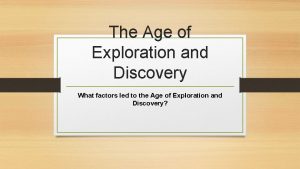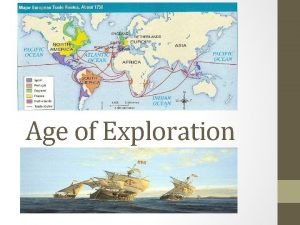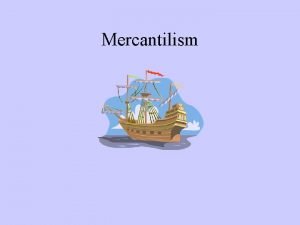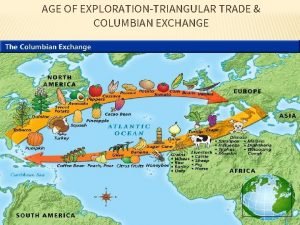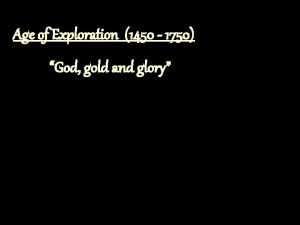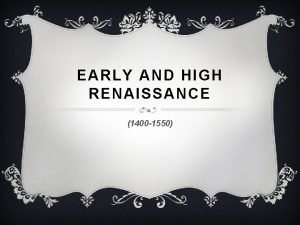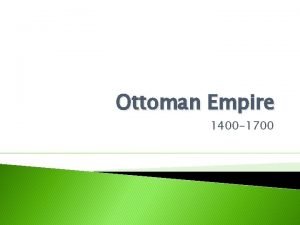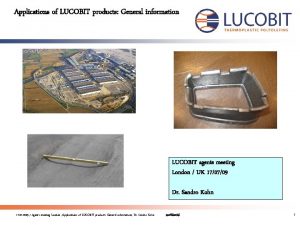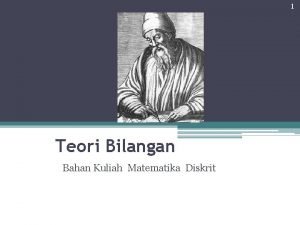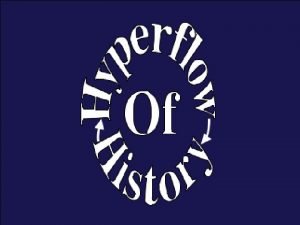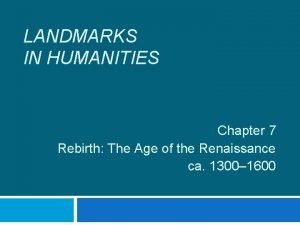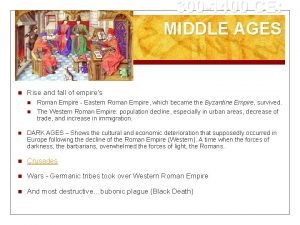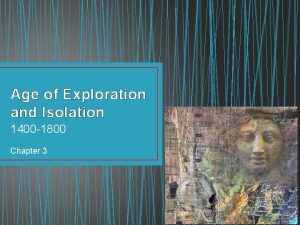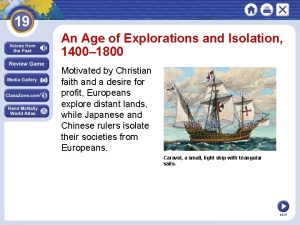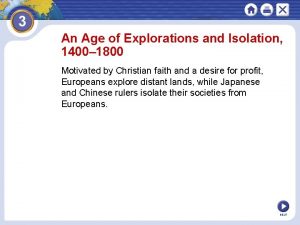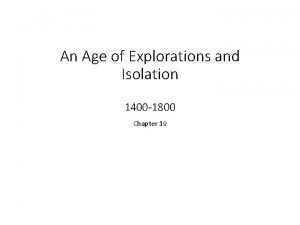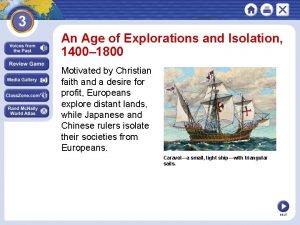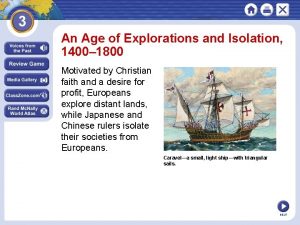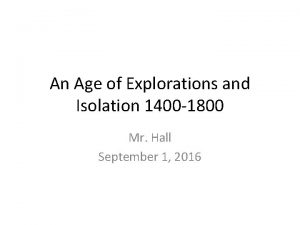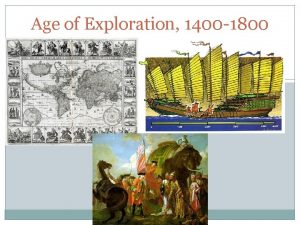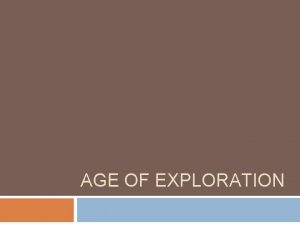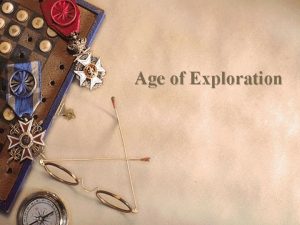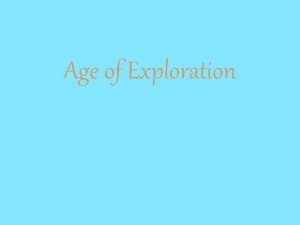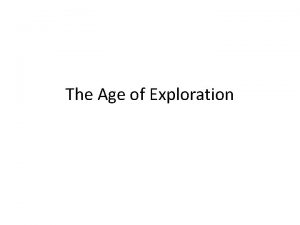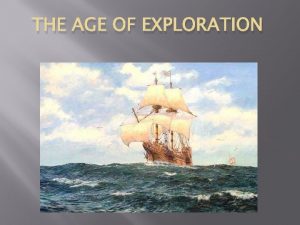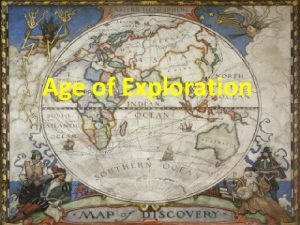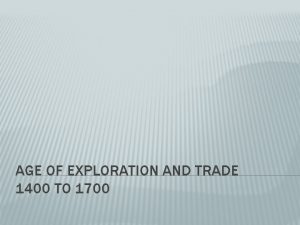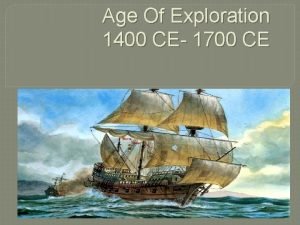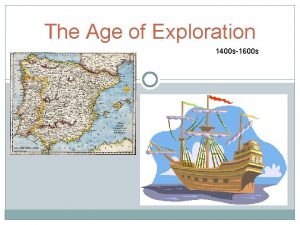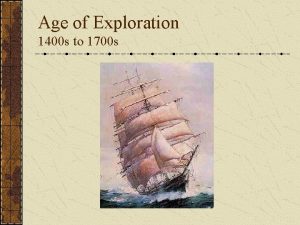AN AGE OF EXPLORATION AND ISOLATION 1400 1800










































- Slides: 42

AN AGE OF EXPLORATION AND ISOLATION 1400 -1800

From the 1400 s to the 1700 s, Europe experienced an “Age of Exploration” The Renaissance encouraged curiosity & a desire for trade As a result of exploration, European nations grew powerful & spread their influence throughout

Merchants began looking for quick, routes to Asia avoid Adirect desiretrade for new sources of to wealth & Italian & was. Muslim the main reasonmerchants for European increase profits exploration The Crusades & Renaissance stimulated European desires for

Kings sponsored voyages Thewho Renaissance inspired newof exploration gained colonies, possibilities for overseas power & prestige new sources of wealth for their nation, & increased power Exploration presented Europeans the opportunity to rise from

European Christians, especially Catholics, wanted to stop the spread of Islam & convert non-Christians to the faith Explorers were encouraged to spread Christianity or bring missionaries who would

European Christians, especially Catholics, wanted to stop the spread of Islam & convert non-Christians to the faith Explorers were encouraged to spread Christianity or bring missionaries who would

THE AGE OF EXPLORATION Before the Renaissance, sailors did not have the technology to sail very far from

Trade & cultural diffusion during the Renaissance introduced new navigation techniques to Europeans Maps were more accurate Magnetic compass Astrolabe used longitude & latitude made sailing more starsand to show

European shipbuilders built a better ship; The caravel was a strong ship that could travel in the open seas & in had Caravels shallow water triangular lateen sails that allowed ships to sail against the wind Cannons & rifles gave ships A moveable rudder made the caravel more maneuverable

Europeans were not the first to explore the oceans in search of new trade routes Islamic merchants explored the Indian Ocean & had dominated the Asian spice trade for centuries before European

But in the late 1400 s, the European sailors did what neither Muslim nor Chinese explorers could: Begin global (not regional) exploration & create colonies to increase their wealth & power

During the Age of Exploration, Portugal created colonies along the African coast, in Brazil, & the Spice

In Portugal, Prince Henry the Navigator started a school of navigation train’s He brought in to Europe sailors shipbest map-makers, builders, & sailing instructors He wanted to discover new territories, find a quick trade route to Asia, & expand Portugal’s power Portugal was the early leader in the Age of Exploration

Prince Henry’s navigation school & willingness to fund voyages led the Portuguese to be the 1 st to explore the west coast of Africa Vasco da Gama was the 1 st explorer to find a direct trade route to Asia by going around Africa to get to India Portugal gained a sea route to Asia that brought them great

During the Age of Exploration, Spain created colonies in

The Spanish government saw Portugal’s wealth & More than any did not want to be left other European out monarch, Ferdinand & Isabella of Spain sponsored & supported overseas expeditions

Columbus reached the Like most educated men of Bahamas in America but the Renaissance, thought that he had Columbus believed the reached islands off the world was round & thought coast of India he could reach Asia by sailing west He made 4 trips to “India” never knowing he was in “America”

England, France, & the Netherlands became involved in overseas exploration & colonization as well

After failing to do so, Champlain founded the French colony of Quebec The French explorer Samuel dea. Champlain The French would soon carve out large colony searched Canada for a northwest passage to along the Mississippi River from Canada to New

Unlike other European nations whose kings paid for colonies, the English colonies were paid for by citizens who formed jointstock companies English colonies formed along the Atlantic Coast of North America by colonists motivated either by religion or wealth

The English explorer James Cook was the first European to make contact with Australia, New

Like England, the Netherlands (the Dutch) allowed private companies to fund exploration The Dutch had colonies in America & Africa, but the Dutch East India Company dominated trade in Asia

End of the Yuan Dynasty Kublai Khan • Black Death Plague devastated China – 1340 s • Yuan (Mongol) Dynasty suffered defeats in Japan, Vietnam and Java. • Kublai Khan’s successors were weak. • Corruption, high taxes on peasants, forced labor, piracy and crime increased. China had a total population of more than 120 million, but a 1393 census only 65 million Chinese surviving. Some • Many groups emerged tofound challenge Mongol rule. of that missing population was killed by famine and upheaval in the transition from Yuan to Ming rule, but many millions died of bubonic plague.

• Expanded the Empire to include Tibet, Mongolia, Taiwan and Manchuria • Controlled Korea and Vietnam as Vassal tributary states. • Expansion was seen as a defensive necessity against nomadic invaders • Signed Treaty of Nerchinsk (1689) that marked Chinese -Russian border

Recovery and Repair • Focus on agricultural foundation – Recovery of • Efficient tax collection. Hongwu ordered surveys and Population censuses to collect data • Active traders in the Indian Ocean – ports of Hangzhou, Guangzhou • Major products were silk, cotton, fine porcelain • Traded for silver with Europe and Japan • Stressed internal trade Economic Recovery Repaired canals, reservoirs and irrigation system, planted trees – Repaired Infrastructure Recovered sense of stability! •

Rebuilding of Dynasty Emperor Yongle Protection of the Dynasty • Rebuilt & added to Great Wall • Repaired the Grand Canal

Reconnaissance and Building of an Empire • 1405 - Emperor Yongle commissioned the building of an enormous fleet for aggressive maritime expeditions. • Led by Zheng He Admiral Zheng He Explore trade opportunities in “Western Ocean” Diplomacy Opened relations with 200 new societies Demonstrate strength, Power, Tribute System: Collect tribute, gifts Rituals of submission

Zheng He and the Treasure Fleet The flagship of the fleet was a nine-masted vessel measuring 440 feet, carrying 1, 000 men. In comparison, Columbus’ St. Maria was

Reconnaissance and Building of an Empire Land travel not reliable after fall of Mongols TAP INTO INDIAN OCEAN BASIN TRADE . Calicut it ra St of M ca ac al

FALL OF THE MING AND RISE OF THE QING Period 4: 14501750 After Zheng He died, the Treasure Fleets were dismantled and banned from being used. Government sponsored voyages ceased and all official records of Zheng He’s travels were destroyed! 16441911 The Ming Dynasty discontinued the Treasure Ship voyages mainly due to their Confucian ideals. However, despite the short term financial and military benefits, China’s absence in world trade would allow Western Europe to dominate the region in the long term.

RISE OF THE QING rs Weak Rule led to increased corruption 16441911 Defense efforts costly, Led to high taxes Famines, hardships led to Peasant Revolts Qing hired Manchu warriors to put down peasant revolts By 1644, the Manch u swept into Beijing and claimed the Manda te of Heaven – Qing Dynasty!

THE QING DYNASTY Qing Government As foreign invaders, the Manchus faced years of resistance from Chinese subjects still loyal to the Ming! • Qing bureaucracy and court ceremonies similar to Ming • Continued Confucian rituals and allowed Ming officials to keep • Continued civil service exams and were generous patrons to the arts • Lowered taxes and state labor demands. • Repaired infrastructure – roads, bridges, dikes, canals,

THE QING DYNASTY Qing Society • Manchus made up less than 2% of the population – Manchus prohibited from marrying Chinese • Men had to wear hair in traditional Manchu style called a queue – form of submission • Women remained confined to the household – footbinding and female infanticide was common

THE REIGN OF EMPEROR KANGXI 1661 -1722 • Strong and effective 61 year reign kept tensions low • Kangxi was a significant Confucian scholar • Patronized arts, opened Confucian schools and a national library • Created encyclopedia and a dictionary of history and thought • Wanted to be benevolent Confucian ruler – lowered taxes, expanded empire • Tolerant of Christians and interested in foreign ideas and technology

THE QING DYNASTY • Brought Stability to China – peace and prosperity • Expanded borders and dominated • Great rule of Kangxi led to golden age • Continued policy of isolation and strict economic

TOKUGAWA JAPAN For years warring states prevented unification Toyotomi Hideyoshi, a strong general, unified Japan in 1590 After his death there was a struggle for power

TOKUGAWA IEYASU Starting in 1603, he created a shogunate that lasted until 1868

TOKUGAWA He and Hideyoshi are consider two of the greatest leaders of feudal Japan He forced the daimyos to live at the new capital city of Edo (eventually it becomes Tokyo)

TOKUGAWA Tokugawa regime was focused on reestablishing order in social, political, and international affairs His successors bound all daimyos to the shogunate and limited their power/land Only four social classes: Warriors, peasants, artisans, merchants (tradesmen)

TOKUGAWA During the Tokugawa Shogunate there was relative peace Leaders were able to focus on creating roads, cities, banks and schools Agriculture, commerce and manufacturing, and the merchant class all increased Rise in Kabuki theater and Bunraku puppet theater

ISOLATION • The leaders did not like foreigners and missionaries coming into their country • Ban on Christianity - 300, 000 Forced underground • Main religion was Shinto and the main philosophy was Confucianism

ISOLATION LASTED FOR 200 YEARS • 1635 – Act of Seclusion no one allowed in or out • If a person left he/she would not be allowed to return • Exception: Small Dutch outpost in Nagasaki Harbor • Japan did still trade with Korea and China!
 Dutch exploration routes
Dutch exploration routes Mercantilism
Mercantilism Iron age dates
Iron age dates Iron age bronze age stone age timeline
Iron age bronze age stone age timeline The age of exploration outcome china and japan's reactions
The age of exploration outcome china and japan's reactions What was the outcome of china's age of exploration?
What was the outcome of china's age of exploration? What are the three g's of european expansion
What are the three g's of european expansion Gold god glory
Gold god glory Explain god gold and glory
Explain god gold and glory Chapter 19 an age of explorations and isolation
Chapter 19 an age of explorations and isolation Joint-stock companies during the age of exploration
Joint-stock companies during the age of exploration The age of exploration lesson 1
The age of exploration lesson 1 Age of exploration diagram
Age of exploration diagram Age of exploration videos
Age of exploration videos Heroic age of antarctic exploration
Heroic age of antarctic exploration Age of exploration webquest
Age of exploration webquest Jacques cartier legacy
Jacques cartier legacy Age of exploration motives
Age of exploration motives God gold and glory
God gold and glory Conquistador vocabulary
Conquistador vocabulary Columbian exchange potatoes
Columbian exchange potatoes What factors led to the age of exploration
What factors led to the age of exploration Age of exploration jeopardy
Age of exploration jeopardy Age of exploration saq
Age of exploration saq The age of exploration definition
The age of exploration definition Mercantilism during the age of exploration
Mercantilism during the age of exploration The 3 g's of european exploration
The 3 g's of european exploration The age of exploration outcome the atlantic slave trade
The age of exploration outcome the atlantic slave trade The age of exploration outcome the atlantic slave trade
The age of exploration outcome the atlantic slave trade Triangular trade vs columbian exchange
Triangular trade vs columbian exchange Age of exploration gold
Age of exploration gold Trust vs mistrust example
Trust vs mistrust example Early and high renaissance (1400–1550)
Early and high renaissance (1400–1550) Ottoman empire 1400
Ottoman empire 1400 Map of asia 1400
Map of asia 1400 Lucofin 1400 mn
Lucofin 1400 mn Tentukan pbb dari 315 dan 825 dengan algoritma euclidean
Tentukan pbb dari 315 dan 825 dengan algoritma euclidean 1000-1100 lexile books
1000-1100 lexile books Scoperte geografiche 1400
Scoperte geografiche 1400 Ptmeg 1400
Ptmeg 1400 1400*74
1400*74 Landmarks in humanities 5th edition
Landmarks in humanities 5th edition 300/1400
300/1400
